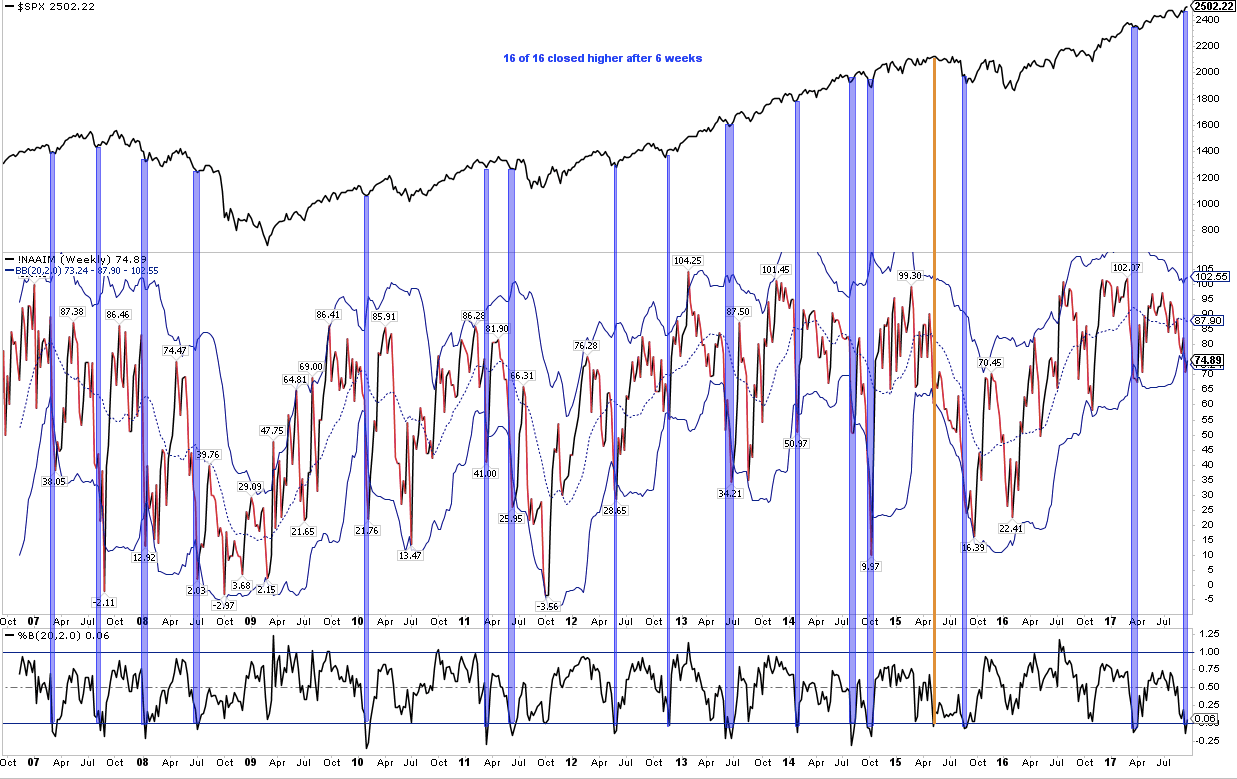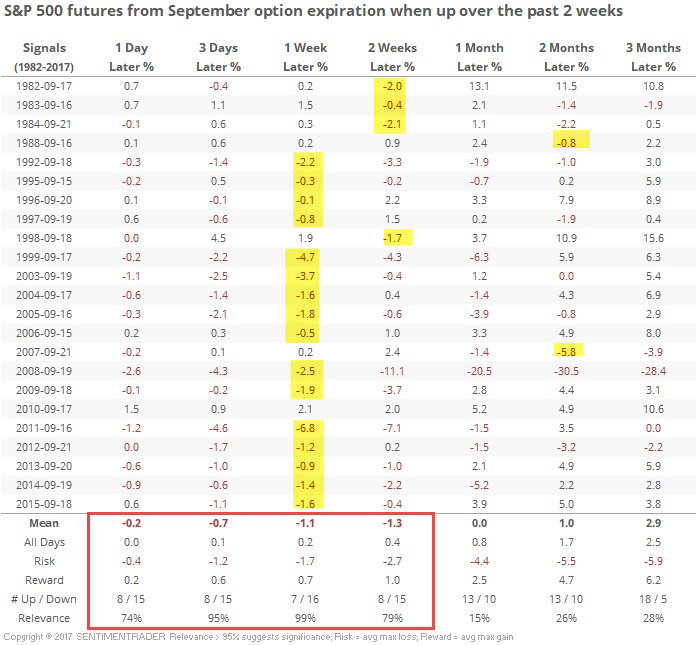Summary: The major US indices all traded at new all-time highs (ATH) this week. Even the lagging small caps index closed at a new ATH on Friday, and transports are very near a new ATH. Persistent strength like that seen throughout 2017 has almost always continued into year-end. However, like last week, a few studies suggest short-term upside will likely be limited. The third quarter ends on Friday.
US equities are now in the second longest and second strongest bull market of the post-war era.

This bull market is not showing signs of ending. This past week, SPX and DJIA made new all-time highs (ATHs) on Wednesday and NYSE and RUT made new ATHs on Friday. All the main US indices have now made a new ATH in the past two weeks.

As an example of how persistent the current trend is, consider this: this past week was only the second time since 1995 that SPX did not trade lower than the close of September OpX at least once. The only other exception was 2001 when SPX lost 12% during OpX week.
A month ago, weakness in transports raised the concern among many pundits that a "Dow Theory" sell signal was likely. Since then, transports have risen 7.5% and closed Friday a mere 0.3% off its ATH.
The rebound in the lagging transports and small caps should reassure those that previously considered their weakness to portend broader weakness in equities. This is yet another example of how breadth weakness is a highly unreliable indicator for anticipating turns in the market. For a fuller explanation of this, read further here.

Further gains into year-end appear to be strongly odds-on.
First, since 1928, when SPX has made a 12-month high in September, it has then risen in the 4th quarter 83% of the time (from Liz Ann Sonders).

Second, since 1928, when SPX has risen in every month from May through September, it has risen in the 4th quarter every time. SPX would have to fall 1.2% this week to invalid this study (from Ryan Detrick).
Third, active investment managers became bearish last week, with NAAIM sentiment closing under its two standard deviation weekly Bollinger® Band (middle panel). This has happened 16 times since the survey started in 2006 and SPX (upper panel) has closed higher 6 weeks later every time (from Cam Hui; his post is here).


This sentiment study is consistent with those presented by BAML in our post last week (read further here). It is also consistent with data from AAII.
Fourth, economic data continues to point to further growth, conditions under which bear markets are very unlikely, especially within a few months. Growth in the index of leading indicators has turned negative ahead of the 3 recessions in the past 30 years; in contrast, current growth is accelerating (from Jim Sullivan).

Even shorter-term, there should be further upside in US equities.
First, the broad NYSE index closed higher 5 days in a row this past week, with that streak ending on Wednesday. In the past 5 years, the SPX has then closed higher within the next week 85% of the time (n=27 instances). This implies a close over Wednesday's ATH at 2508 is likely ahead.
Second, SPX has closed above its rising 10-dma every day for more than 3 weeks. Since 1995, when these long streaks have eventually ended, it has led to at least one higher close within the next week nearly 90% of the time (data from Rob Hanna). Repeating our comment from last week, on weakness, look for first support (and a positive reaction) at the rising 13-ema (which roughly equals a 10-dma; green line).

Third, price highs are most often preceded by a momentum high on the daily chart. In other words, the trend weakens before it reverses (red lines in the top panel; arrows in the main panel). The momentum high so far was on Wednesday and should most likely be followed by a price high. This is consistent with the two short-term studies mentioned above.

All of that said, there are three reasons to suspect any short-term gains will be given back.
First, the one-month average equity-only put/call ratio reached a 9 month low this week. Prior to 2017, current put/call levels had consistently led to downside of at least 3% and often more. Using the backtest engine from Sentimentrader, prior instances in the past 5 years have preceded a lower close within the next month 65% of the time and within the next two months 77% of the time (if you wish to become a Sentimentrader subscriber, please use this link which results in a small contribution to the Fat Pitch).

Second, the volatility term structure, which compares one month volatility (VIX) to three month volatility (VXV) is now also at one of the largest extremes in several years. After similar instances, SPX has moved sideways or lower over the next 1-3 weeks; if SPX moved higher, those gains were given back (upper panel).

Third, the two weeks at the end of September are typically weak. SPX closed marginally higher this week but poor seasonality is still a headwind. That has most often been the case when SPX rallies into OpX (a week ago): since 1982, SPX has closed lower within the next two weeks 87% of the time, and within the next 2 months 96% of the time (from Sentimentrader).

Net, US equities continue to make new ATHs and the outlook into year-end is favorable. Several studies suggest further short-term upside is likely limited.
The macro calendar this week is heavy: new home sales on Tuesday, durable goods on Wednesday, GDP on Thursday and PCE on Friday. The third quarter also ends on Friday.
Recent hurricanes are likely to have a short-term negative impact to upcoming economic data. In the past, growth has quickly resumed. Thus, jobless claims recently spiked higher after Harvey, as it also did after Katrina and Sandy (first chart; from Bespoke). GDP forecasts have also fallen in the wake of Harvey (second chart; from the Atlanta Fed). This should be only temporary.


